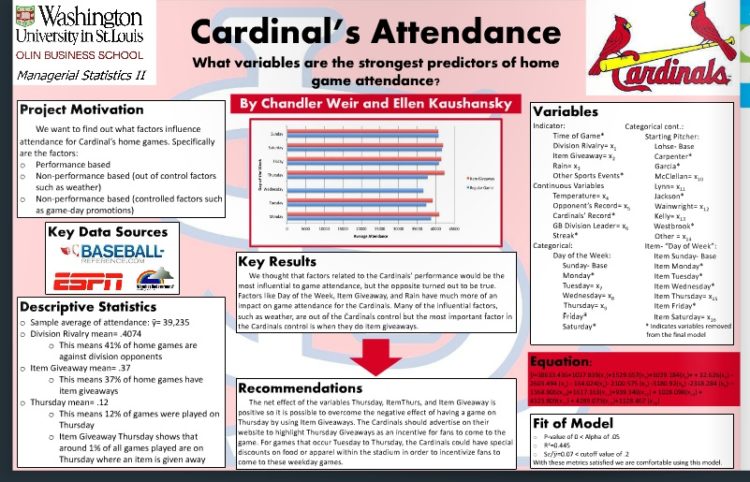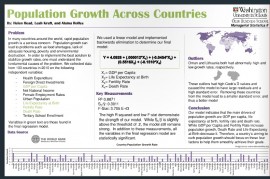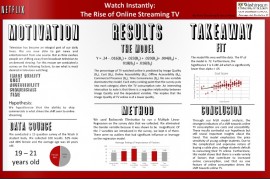Statistics are becoming a competitive necessity for companies large and small. No longer the domain of a few back-office analysts, companies today require statistical knowledge as part of a well-rounded analytical background. That’s where QBA121 – Managerial Statistics II – comes in. In the course, we develop the foundational skills for statistical analysis, primarily regression modeling.
In a world surrounded by Big Data opportunities, students need to be comfortable with statistics and have the tools to analyze data to develop managerial recommendations.
The QBA121 project does just that. It allows students to explore and analyze data that interests them. The poster session gives them an opportunity to display their insights to a broad audience. Their projects reflect both their interests and the competencies they mastered during the course. Most of the students applied regression analysis to gain insight on a topic they were knowledgeable about. Statistics allowed them to expand their knowledge while grounding insights in data, rather than conjecture. In many projects initial hypotheses were only partially supported, and the data determined that multiple factors impact the dependent variable.
During the course we learned why statistics is a foundation in so many disciplines in academia. It can be applied to diverse topics that students will explore in their academic journey. Similarly, the topics chosen for the course project reflect the diversity of students’ interests.
Movies were of interest this past semester, with students identifying which movie awards are best predictors of Academy Award nominations; how a book’s genre and the author’s productivity impact a movie’s success; and which factors are effective predictors of Best-Actor Oscar Nominations.
Crime statistics make for effective, if not particularly uplifting, projects. Here we learned how education, poverty, population density, and law enforcement impact local crime. We also found out that the key factors determining a city’s crime index are assaults, rapes, and larceny.
Finally, sports frequently generate a lot of interest in the class. Every Monday-morning coach wants to know why his team isn’t living up to their expectations. For those that want an in-depth look at college basketball, we have some advice on which teams will succeed in “March Madness”.
To see a sample of the projects presented, please view the Spring 2016 poster session book, click here.
Please join us next semester as we showcase projects from another talented cohort.
Guest blogger: Eli Snir, Senior Lecturer in Management




 One of the goals of the course is to demonstrate the broad applicability of statistics, and specifically of regression analysis, to any area of interest. And the term papers reflect that. They are as broad and as encompassing as the university, drawing on nearly every discipline taught here.
One of the goals of the course is to demonstrate the broad applicability of statistics, and specifically of regression analysis, to any area of interest. And the term papers reflect that. They are as broad and as encompassing as the university, drawing on nearly every discipline taught here. Students are expected to explain their analysis to various constituents, some desire a qualitatively understanding while other challenge students on statistical methodology. Invariably, students in the course address all questions comprehensively and confidently.
Students are expected to explain their analysis to various constituents, some desire a qualitatively understanding while other challenge students on statistical methodology. Invariably, students in the course address all questions comprehensively and confidently.

